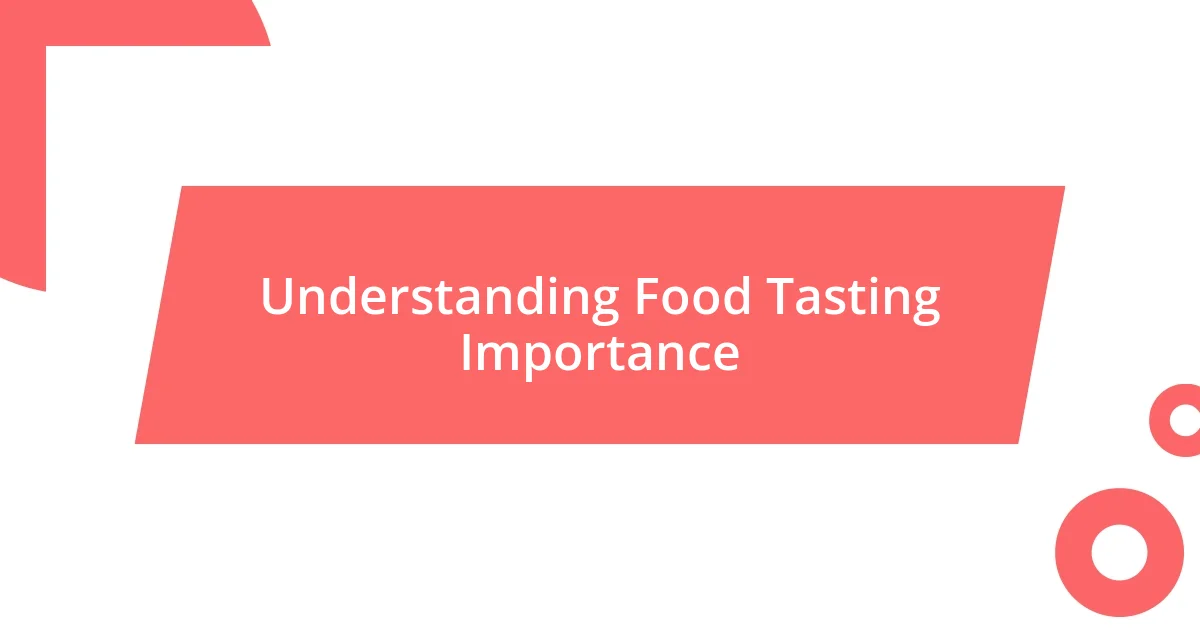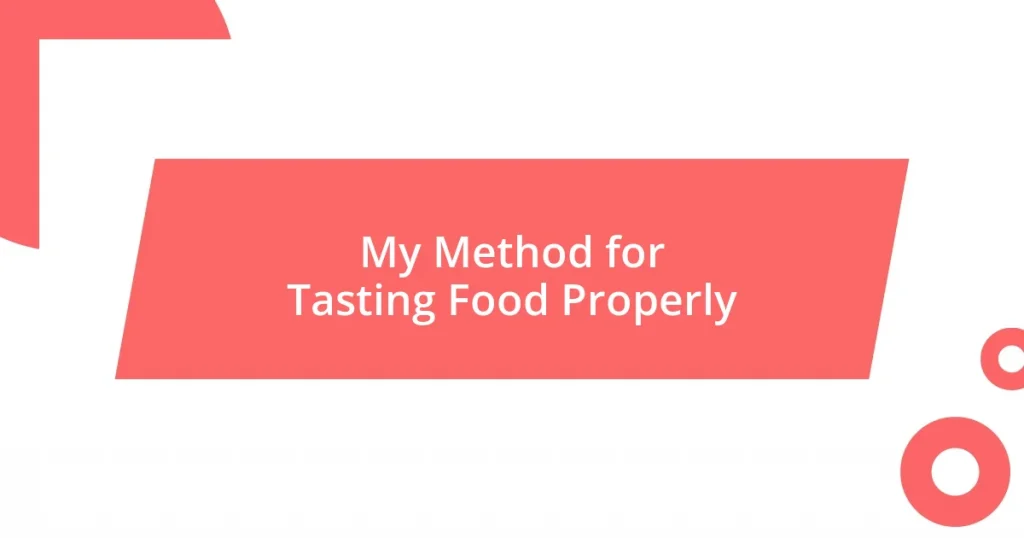Key takeaways:
- Food tasting is a sensory experience that connects us to culture, enhances cooking skills, and promotes mindful eating for better health.
- Preparation for food tasting involves creating an inviting atmosphere, planning diverse menus, and fostering an open mindset.
- Documenting tasting experiences through notes fosters creativity and emotional connections to food, allowing for deeper appreciation and skill improvement over time.

Understanding Food Tasting Importance
Food tasting goes far beyond mere sustenance; it is a sensory experience that allows us to connect with culture and tradition. I remember savoring a bowl of pho in Vietnam, where each slurp was layered with the stories of family recipes handed down through generations. Have you ever considered how flavors can evoke memories or emotions, transporting you back to special moments in your life?
Understanding the importance of food tasting can also enrich our approach to cooking. When I experiment with new ingredients, I focus on each element’s unique flavor profile. This not only enhances my culinary skills but also fosters a deeper appreciation for the complexities of taste. How often do we truly stop to appreciate what’s on our plate?
Moreover, the practice of mindful tasting can significantly influence our health and well-being. By taking the time to truly savor our food, we become more in tune with our body’s responses. I find that when I eat slowly, I can better recognize when I’m satisfied, which helps me avoid overeating. Isn’t it fascinating how an intentional pause can change our relationship with food?

Preparing for a Food Tasting
Preparing for a food tasting requires both logistical planning and a mindset that values the experience. I remember my first organized tasting event; I was both excited and a bit anxious about what to expect. Setting the right environment made all the difference. I suggest creating a calm and inviting space, free from distractions, so you can fully immerse yourself in the flavors and aromas.
Here are some practical steps to ensure a successful tasting:
- Plan Your Menu: Choose a diverse range of foods that will showcase different flavors and textures.
- Gather Your Tools: Ensure you have the necessary utensils, such as tasting spoons, plates, and napkins, all within easy reach.
- Set the Mood: Dim the lights or play soft music to create a relaxed atmosphere that enhances your sensory experience.
- Clear Your Palate: Have plain water or neutral foods, like unsalted crackers, ready between tastings to refresh your palate.
- Mind Your Mindset: Approach each taste with curiosity and openness, eager to discover new flavors.
Taking these steps can really elevate your food tasting experience, making it more enjoyable and insightful.

Developing Your Palate Skills
Developing your palate skills is a journey I find truly enriching. For me, it started with simply paying closer attention. I remember attending a wine tasting event where each sip compelled me to articulate what I was tasting. Was it fruity, nutty, or perhaps floral? This practice sharpened my senses, prompting me to relate those tastes back to my own cooking and dining experiences.
In my exploration, I’ve come to realize that keeping a tasting journal can be incredibly helpful. When I sample a new dish or ingredient, I jot down my impressions. What flavors stand out? Which combinations excite my taste buds? This not only enhances my understanding but creates a delightful roadmap for future culinary adventures. Have you ever considered recording your impressions after a meal? It’s a rewarding method that deepens appreciation for the art of tasting.
The art of mindful eating can elevate these skills even further. I often find that when I savor each bite, the individual flavors begin to reveal themselves. I recall a moment enjoying a caramelized onion tart; as I chewed slowly, the sweetness of the onions and the buttery crust danced together, creating a small orchestra of flavors. It made me wonder: how many other delicious moments have I missed by eating too quickly? Cultivating mindful tasting leads not only to a greater appreciation of food but also to a profound connection with the culinary world.
| Skill | Practice |
|---|---|
| Flavor Recognition | Attend tastings and describe flavors. |
| Tasting Journals | Write notes on tastes and impressions. |
| Mindful Eating | Savor each bite to uncover complex flavors. |

Common Tasting Techniques to Master
Understanding the nuances of food involves mastering various tasting techniques. One technique I’ve embraced is the “swirl and sip” method, particularly useful in wine tasting. I remember swirling a glass of Chardonnay during my first tasting session and suddenly being hit with an array of aromas that were previously unnoticed. Have you ever taken the time to really breathe in the scent of your drink before tasting? It’s an eye-opener; I realized that aroma is the prelude to flavor, setting the scene for what’s to come.
Another technique worth mastering is layering flavors. I love experimenting with multi-component dishes, breaking them down bite by bite. So, when I had a beautifully crafted sushi roll, I took a moment to savor each element – the creamy avocado, the fresh fish, and the tangy soy sauce. Separating each component allowed me to appreciate how they harmonized together. It’s intriguing how a single bite can reflect a symphony of flavors. Have you ever tried dissecting a dish in this way? You might find a new appreciation for its complexity.
Finally, I can’t stress enough the importance of using all your senses in food tasting. I fondly recall a cheese tasting where the texture of each cheese was as memorable as its taste. I took a moment to feel the creamy Brie melt on my tongue versus the sharpness of aged cheddar that crumbled delightfully. Engaging with what you see, smell, and even hear as you taste transforms the experience. It’s almost like your taste buds are just one part of a larger orchestra playing a beautiful melody that sings in your mouth. Isn’t that a captivating thought?

Documenting Your Tasting Experience
Documenting your tasting experience can be a delightful way to connect more intimately with the food you enjoy. I remember the first time I wrote down my thoughts after a meal. It was a simple pasta dish, but as I scribbled away, I realized I had uncovered layers of flavor I hadn’t noticed before. Each note became a mindful reflection on what had once been just a rush to the table.
I often find myself revisiting my tasting notes, like a cozy journal filled with culinary memories. One time, while noting the ingredients in a complex curry, I highlighted the surprising burst of cardamom amidst the heat. That little detail sparked a revelation—suddenly, I craved a dish that combined those flavors. Have you ever thought about how a single note can ignite new ideas in your cooking? It’s fascinating how documenting can spark creativity!
Sometimes, it’s the emotions tied to flavors that resonate most deeply. I recall a moment crafting a dessert inspired by a childhood memory, where I too noted the mix of nostalgia with every bite. The warmth of cinnamon brought me back to a family kitchen filled with laughter and spice. It’s incredible how writing down your tasting experiences can uncover those hidden stories tied to food. Wouldn’t you agree that every bite is a potential journey waiting to be documented?

Improving Your Tasting Over Time
Improving your tasting skills doesn’t happen overnight; it’s a gradual journey that requires both practice and reflection. I vividly remember my first attempts at tasting coffee. I used to slurp it down, barely noticing the difference between a dark roast and a light one. But as I started to slow down and pay attention to the subtle notes of chocolate or fruit, every cup transformed into an adventure. Isn’t it amazing how just a little mindfulness can uncover so many layers?
Diving deeper into flavor profiles is something I’ve really enjoyed over time. Not long ago, I hosted a small tasting party where we compared different varieties of chocolate. Each piece told a story, whether it was the fruity aftertaste of a single-origin bar or the creamy richness of a blended chocolate. I found it fascinating that as we discussed our impressions, our individual preferences highlighted the diversity in our palates. Have you ever realized how your taste can evolve based on your experiences and interactions with others?
One thing I’ve learned is to embrace experimentation as part of the tasting process. I recall a night when I tried pairing spicy food with unexpected beverages like fruity ciders instead of the usual water. It completely changed how I experienced the heat and flavors! This willingness to explore can significantly enhance your tasting journey. What’s stopping you from pushing your boundaries? Each new flavor you encounter enriches your understanding, allowing you to taste with greater depth next time.















